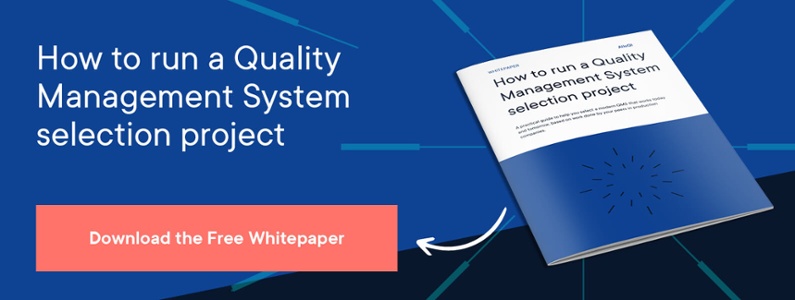As we already know, quality doesn’t occur by chance. But as William A. Foster said, quality is the result of high intention, skillful execution, sincere effort, and intelligent direction. To achieve high quality, customer satisfaction, and remain compliant with policies and regulations, manufacturers started to use management frameworks – better known as Quality Management Systems (QMS).
Implementation started in the late 20th century. And, while using a QMS isn’t a new concept, the scope of quality systems has evolved over time. This article highlights why a QMS is important and talks about the benefits of implementation.
Standards and evolving needs
The importance of quality only grew over time. Similarly, the need for Quality Management Systems rose after the first implementation. The systems were designed to help organizations formalize requirements and are considered valuable assets safeguarding against common quality issues.
The most popular standard for QMS is ISO 9001:2015. Published by the International Organization for Standardization, its quality principles should be used as a starting point in the pursuit of continuous improvement. It applies to any organization, regardless of size or industry.
As mentioned above, the scope of quality systems was subject to change. The trigger for this was the shift in customers’ needs. Nowadays, a QMS also addresses concepts like sustainability and transparency since these have become central to customer satisfaction.
Quality Management Systems: a quick selection guide
If we zoom out, the role of a QMS is twofold: it helps meets customers’ needs and addresses organizational requirements. Still, every business is different and so there is no one scope or universal set of requirements. When selecting a QMS, it is essential to:
-
Understand the meaning of quality
By defining quality through clear objectives, organizations translate customer needs into strategic goals. Quality objectives lend purpose to the QMS and provide a clear vision on how to measure progress. The benefits of a quality-driven approach are better products and improved profitability. This, in turn, can lead to customer satisfaction.
Still wondering about the level of quality in your business? Our quality maturity model is designed to highlight the strengths and expose potential weaknesses of all aspects of your quality management, giving you the input necessary to strategize for positive change. -
Define processes and policies
Next to understanding the role of quality, it is equally important to document policies and processes. This will help structure responsibilities and clearly define roles within the organization. A quality manual highlights the scope and requirements of a QMS and its invaluable role within the organization. -
Establish tolerances and success metrics
As stated earlier, quality does not occur by chance. Within a QMS, organizations can easily define standard values and success metrics for their processes. Make sure you implement Quality Control and Quality Assurance – as these are essential elements, which will allow you to monitor performance, ensure consistency, and act promptly to make necessary changes. -
Choose adequate software
Quality Management Software – confusingly using the same three-letter abbreviation of QMS – plays a crucial role for a quality management system, especially for companies with a worldwide presence. Good software supports QMS and ensures that it achieves its scope. -
Consider continuous improvement
In this fast-moving world, where both technology and regulations develop with the speed of light, choosing a QMS needs to consider the needs of tomorrow. The system that you pick today will likely be in your business for five to up to even ten years.
To help you select a QMS solution that fits your business both today and tomorrow, we have created a framework for the selection process.
Exposure to risk without a QMS
A QMS acts as a framework that can guide organizations to achieve quality objectives and focus on improvement. But what if your organization decides not to invest in one? Is a QMS really needed?
Deciding against a QMS might initially seem like a way to reduce costs – saving expenditures on software, technology, implementation, and the time to get familiar with the system. However, there are great risks associated with it – from inconsistent product quality, losing their competitive advantage, and producing more waste to regulatory delays and costly fines. Moreover, it’s a barrier to receiving ISO certification.
Conclusion
A Quality Management System (QMS) can be considered a great asset. Implementing one, organizations make use of a framework that helps them to manage their data, improve operations, while at the same time prevent common quality issues.
As every business is different, there is no single scope or universal set of requirements for a QMS. That means organizations will have to pick a system that is both flexible and fits their business. When selecting a QMS, it is essential to clarify its scope and analyze potential benefits.
Without implementing a QMS, organizations run higher risks. While initially, this move might seem like a cost-saver, businesses are likely to incur more costs in the long run.
How to run a Quality Management System selection project
To help you select a new a QMS or LIMS solution, we have created a framework for the selection process.



